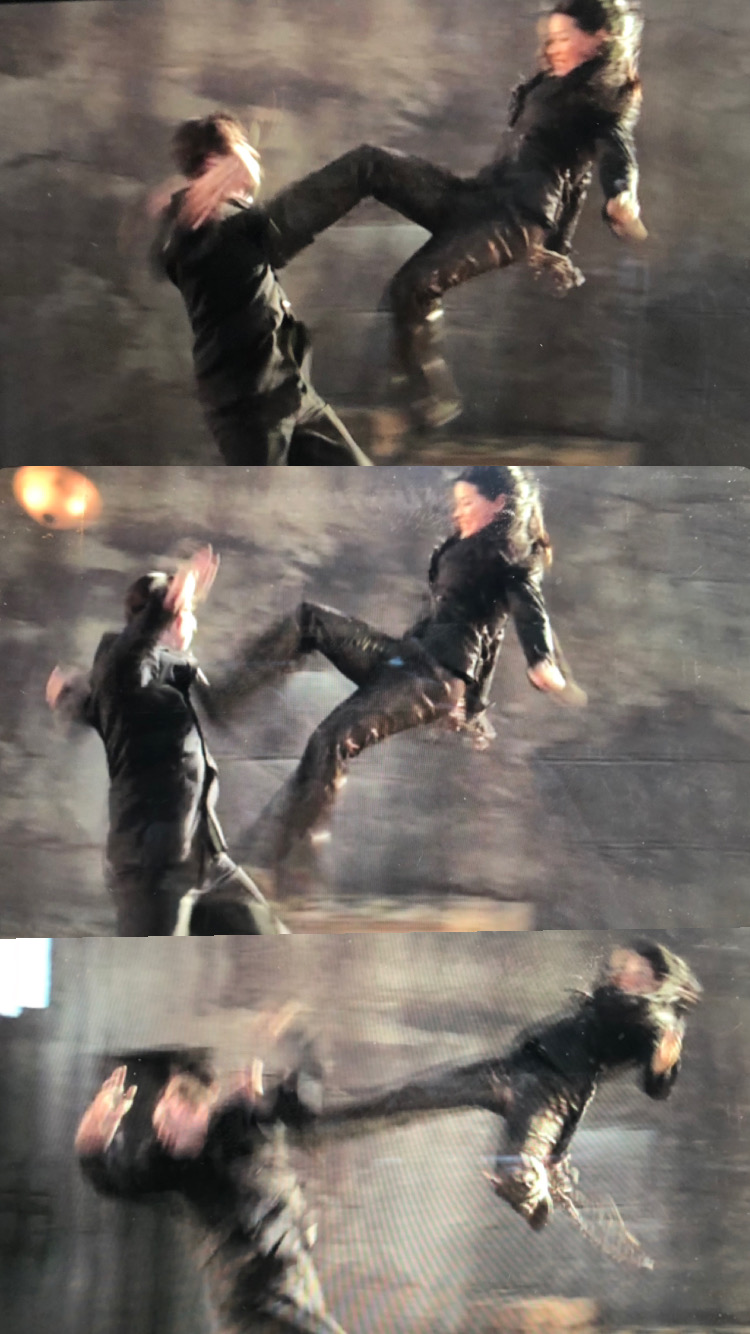Image Attribution: “Assignment 4 – Part A” by Elana Sedor is licensed under CC0. (See interactive map)
Elana Sedor
VISA 1500
Dr. Terryl Atkins
November 22, 2021
Assignment 4, Part A
For this assignment, I re-watched the 2000 film adaption of Charlie’s Angels, starring Cameron Diaz, Lucy Liu, and Drew Barrymore. The film grossed over $40 million at opening and overall grossed over $125 million domestically. This screengrab is from the climactic final fight scene as the Angels battle it out against Knox and his henchmen, who have kidnapped Bosley, intending to find Charlie and kill him. More specifically this is an set of images of Lucy Liu who plays Alex completely annihilating this guy with her crazy running, kicking, and flying in the air move.
This movie is filmed with many different techniques, from quick pans and zooms from the camera, different angles of the same scene are edited together to create a more intense and interesting viewing experience. The use of slow-motion editing to make the Angel’s gravity-defying martial arts tricks look even more exciting. While this image is focusing on Lucy Liu and her fight, this whole scene is rapidly switching back and forth between Liu, Diaz, and Barrymore as they are all involved in other fights. Highlighting all of these women and their badass stunts.
The 2000s Charlie’s Angels is one of the more commercially successful and well-known examples of an action movie with a female lead, more specifically three female leads. This trend of female action leads (FALs) have been increasing since the 1960s but only “peaked in 2000 at 16%.” (Heldman et al. 4) While the percentage of FAL in the 2000s was small, one statistic that rose exponentially during the 2000s was the increase of the Hypersexualized Female Action Lead, (HFAL). With the rise in popularity of action movies in the 1980s and 1990s, there was a change in the FAL “from thin, tough women to heavily muscled killing machines, capable of physically going toe-to-toe with male villains… providing them an opportunity to transcend traditional femininity but also requiring that they conform to male standards of masculine brute.” (Heldman et al. 6) However, the 2000s brought a new era of hypersexualized female action leads. Characters in skin-tight latex suits, revealing their breasts or accentuating the curves on their bodies. While they are still super badass with their martial arts and crime-solving skills, most watchers do not care about what is on the inside when everything on the outside is on full display.
This is one of the selling points of Charlie’s Angels and it is something that the movie capitalized on during promotions. The special edition DVD cover for Charlie’s Angels shows Barrymore, Diaz, and Liu, three very attractive movie stars in their hayday in the 2000s, in latex black body suits, flames behind them, hair blowing in the wind like a cover of a magazine. Throughout the film, while the leading ladies are all tough and intelligent, they also do not stray away from using their sex appeal to get what they need from all the men. Some examples include “Natalie (Diaz) in her Swiss yodeler’s outfit, cleavage prominently displayed… Dylan (Barrymore) in her racetrack disguise, with bleach-blond hair, bright red lipstick, and breasts about to tumble out of her jumpsuit… Alex (Liu) shows her in her tight, black dominatrix outfit.” (Coon 7) In particular, I wanted to focus on Lucy Liu’s character as after rewatching the movie, Lucy Liu being the stereotyped smart and overly-sexualized Asian woman who knows martial arts was honestly hard to look past when watching this movie 21 years after it’s original release.
Works Cited
Coon, David Roger. “Two Steps Forward, One Step Back: The Selling of Charlie’s Angels and Alias.” Journal of Popular Film and Television, vol. 33, no. 1, 2005, pp. 2–11. EBSCOhost, doi:10.3200/JPFT.33.1.2-11.
Heldman, Caroline, Laura Lazarus Frankel, and Jennifer Holmes. ““Hot, Black Leather, Whip”.” Sexualization, Media and Society 2.2 (2016) ProQuest. Web. 22 Nov. 2021.
